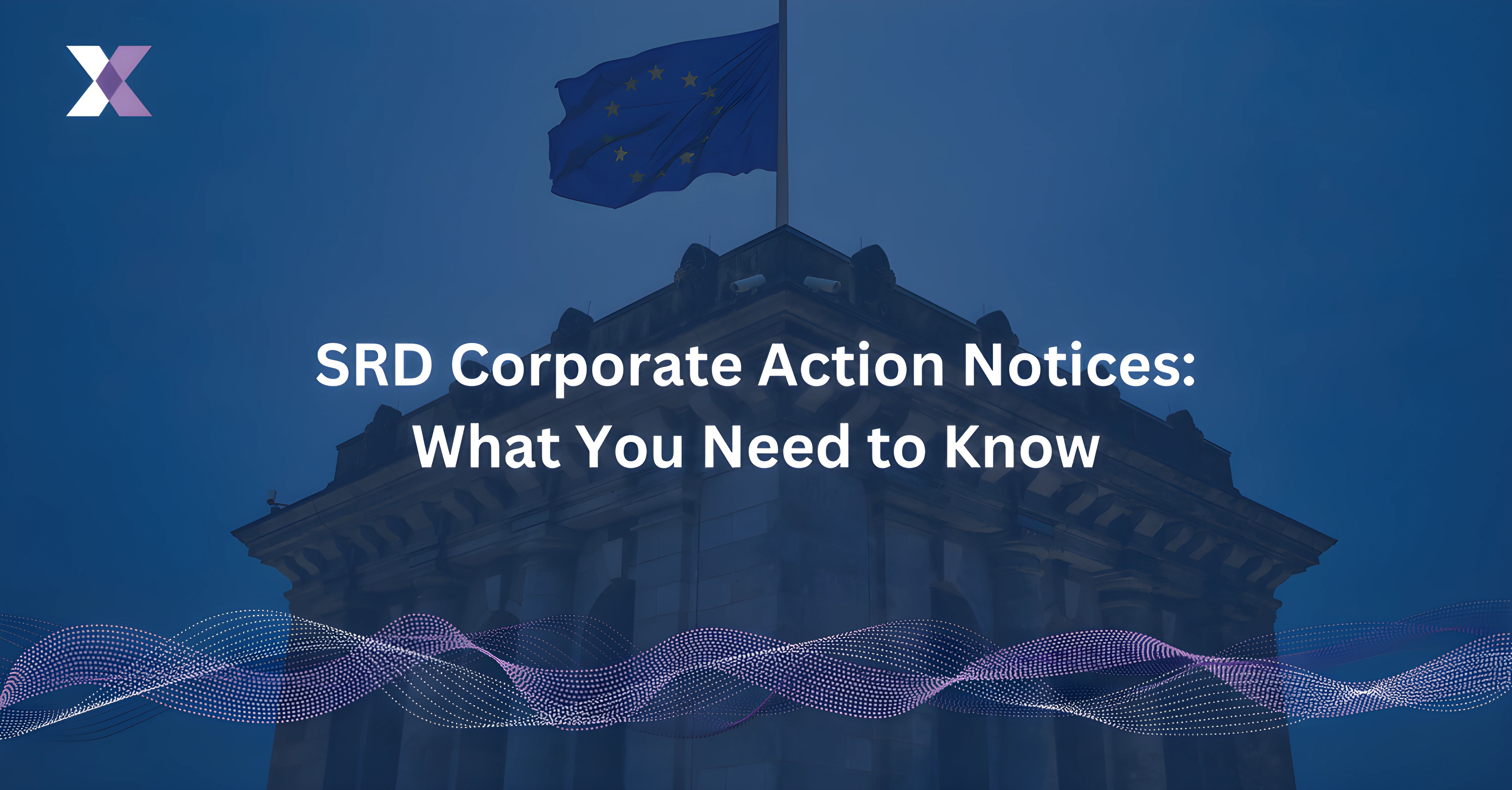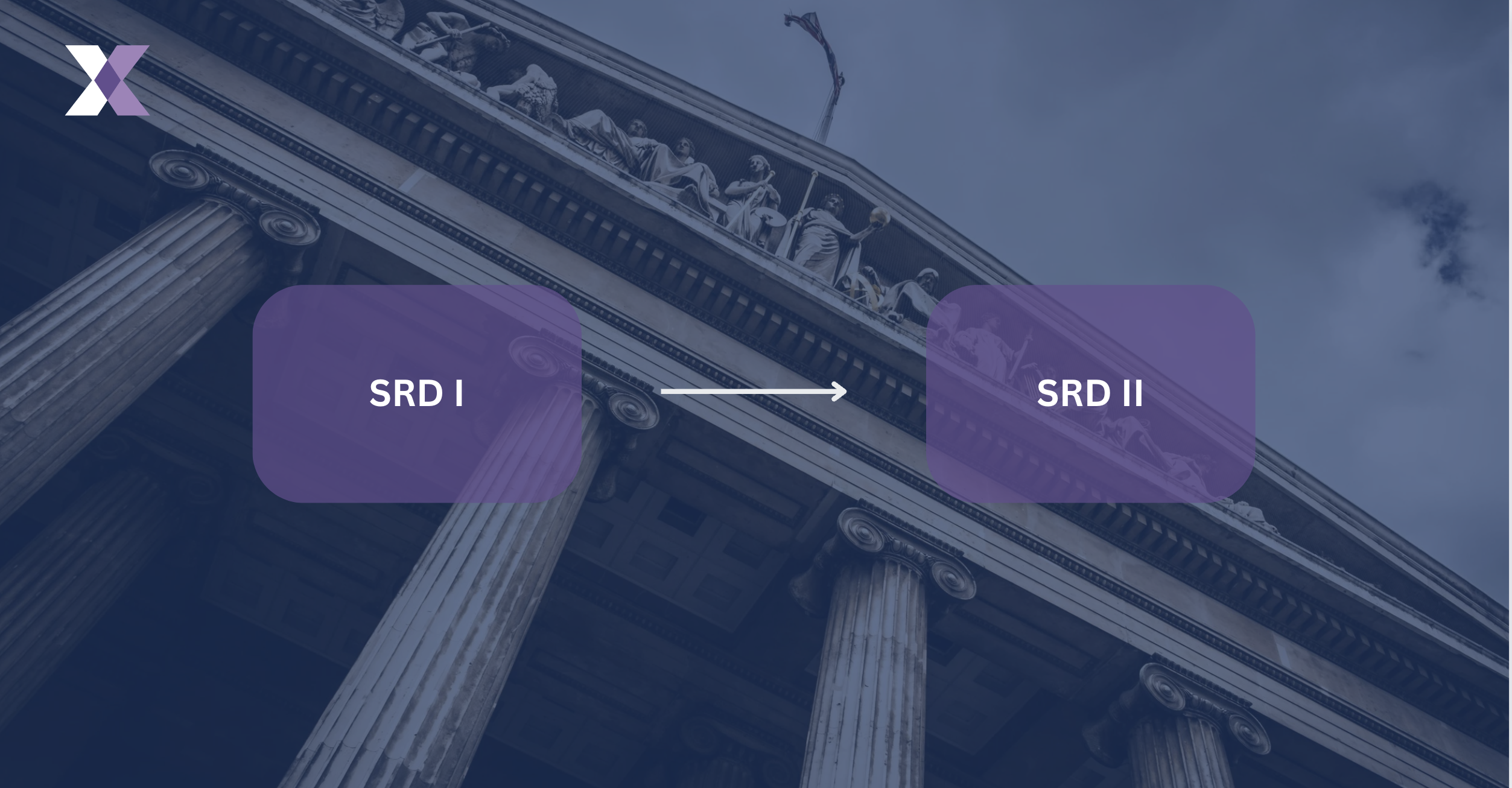Views
Decoding SRD Corporate Action Notices: What You Need To Know

In 2017, the Shareholder Rights Directive (SRD) underwent significant transformations to enhance transparency and improve shareholder engagement within the EU. The updated iteration, SRD II, came into effect in 2019 and introduced new requirements for corporate action notices that impact issuers, intermediaries and shareholders alike.
This article delves into the meaning of SRD corporate action notices, the key changes from SRD I to SRD II, the affected parties, and how companies can stay ahead of regulatory changes in the market.
SRD Corporate Action Notice: What it means and why it’s important

An SRD corporate action notice is a formal communication by an issuer company to inform its shareholders about significant events and decisions that require their attention or action. These notices cover a range of corporate activities, including dividend payments, mergers and acquisitions, stock splits, and voting on resolutions. The primary goal of these notices is to ensure shareholders are well-informed and can exercise their rights effectively.
Under SRD II, the requirements for corporate action notices have become more stringent, aiming to promote greater transparency, accountability and shareholder participation. The enhanced framework mandates timely and accurate dissemination of information from the issuer to the first intermediary and then back after the investor’s decision.
Key Changes from SRD I to SRD II

SRD II builds upon the foundation of SRD from 2007, introducing several key changes to how corporate action notices are managed and communicated. These changes are outlined below.
Enhanced Transparency and Timeliness
One of the most significant changes is the emphasis on transparency and timeliness. SRD II requires issuers to provide detailed and timely information on corporate actions, ensuring shareholders receive notices well before any deadlines. This change aims to eliminate delays and ensure shareholders have ample time to respond.
However, in practice, these processes are hindered by legacy solutions powered by manual batch–driven processing. Additionally, the involvement of multiple parties across the custody chain can lead to delays and transmission of inaccurate or misinterpreted information.
Solutions like Proxymity ensure that golden source information is transmitted directly from the issuer to the investors in real-time, maintaining accuracy, efficiency and transparency across the custody chain.
Improved Shareholder Identification
SRD II introduced stricter requirements for shareholder identification. Issuers must be able to identify and communicate with their shareholders more effectively. This change is particularly relevant for intermediary organisations, as they play a crucial role in maintaining accurate shareholder records and facilitating communication.
The SRD II regulations provide issuers the right to obtain data on their shareholders with a minimum of 0.5% shareholding. However, many EU countries allow issuers to identify all investors with at least one share. It states that shareholder information may be stored for up to 12 months after cessation, including details like name, address, email, LEI, share volume, ownership start date, and share category.
Increased Shareholder Engagement
The SRD II directive placed a stronger focus on shareholder engagement. Issuers are now required to provide more detailed explanations of their decisions and the rationale behind them. This encourages shareholders to actively participate in corporate governance by informing them about the right to attend meetings and vote on agendas.
Issuer’s ability to gain insights into their shareholder base enables them to plan engagement strategies effectively. This connection with investors before, during, and after their shareholder meeting facilitates greater shareholder involvement.
Standardised Formats & Faster Processing
SRD II mandated the use of standardised formats and processes for corporate action notices. This standardisation aims to streamline communication, making it easier for shareholders to understand and act on the information provided. Apart from making it easier for shareholders to exercise their rights, SRD II introduced stricter rules to ensure issuers receive a timely response to disclosure requests. As outlined in our previous article on the impact of SRD II on the shareholder disclosure landscape, intermediaries must now respond to these requests in a machine-readable format same-day or by the next business day depending on the time when they receive the disclosure request, with non-compliance risking potential fines or even jail time.
How are Parties Impacted by the Directive?

The changes introduced by SRD II impact various stakeholders within the custody chain, including issuers, intermediaries, and shareholders. The updated regulations affect the 27 member states of the EU and the U.K., Iceland, Norway and Liechtenstein. Any issuer with a registered office in an EU Member State and shares admitted to trading on a regulated market within an EU Member State falls within the scope of the SRD II directives. Any intermediaries that offer services to shareholders of these issuers, as well as investors and asset managers purchasing shares in these issuers, fall within the scope of the directive even if they are located outside the EU.
Issuers
Issuers are directly affected by the new requirements for corporate action notices. They must ensure that all notices and vote confirmations are accurate, timely, and comply with the standardised formats mandated by SRD II.
Additionally, issuers need to improve their communication strategies to engage shareholders more effectively. They benefit from the directives as they gain the right to identify their investor base at any point during the year.
For issuers, Proxymity’s Shareholder Insights product offers valuable information about their shareholder base, enabling them to tailor their communications and improve engagement. By leveraging these insights, issuers can meet the demands of SRD II more efficiently and foster stronger relationships with their shareholders.
Intermediaries
Custodians, brokers and other intermediaries play a critical role and are held accountable in SRD II implementation.
They are obligated to perform the following:
• Maintain and share accurate shareholder records with issuers upon request.
• Delete shareholder information within 12 months of not holding positions
• Facilitate the seamless flow of corporate action notices and other information between issuers and investors without delay in standardised messaging formats
• Issue confirmations to shareholders regarding voting and the recording and tallying of their votes
• Ensure that shareholders can exercise their rights to participate and vote in meetings
• Publicly disclose any charges for offering the above services. Costs must be non-discriminatory and proportionate to the actual.
To meet these requirements, intermediaries need to adapt their processes and systems to handle issuer requests and provide responses quickly, including updating systems to manage higher volumes.
Additionally, intermediaries are encouraged to adopt the SWIFT ISO 20022 messaging format for standardised shareholder identification and proxy voting compliance.
Proxymity’s Shareholder Disclosure product is designed to assist intermediaries in meeting these requirements. This product streamlines the shareholder identification process and ensures that intermediaries can provide timely and accurate information to issuers and shareholders. Since ISO 20022 migration poses high costs and many challenges, Proxymity can process requests in multiple messaging formats making SRD II compliance seamless for intermediaries.
Shareholders
Shareholders are the ultimate beneficiaries of SRD II. Enhancing transparency, timeliness, and engagement requirements ensures that shareholders receive the information they need to make informed decisions and exercise their rights effectively. The regulations are intended to facilitate cross-border voting, increase transparency of proxy advisors’ policies and enable them to exercise their rights on matters such as remuneration and related party transactions.
However, shareholders must also adapt to the new processes and take a more active role in corporate governance.
Tips for Staying Ahead of SRD and Other Regulatory Directives

Complying and staying on top of SRD II or any other regulations requires a comprehensive approach that involves updating processes, systems, and communication strategies. Here are some key tips that companies can take to ensure they are ready for any new regulations.
Conduct Regular Compliance Audits
The first and most important step is to conduct regular audits to assess the company’s compliance with relevant regulatory directives. This audit should assess your current processes and identify any gaps or areas that need improvement. It should look at the ability to adapt to changes in the market. A crucial aspect of the audit is the level of technology leveraged considering that digital transformation can be about key improvements in most companies.
A survey by Deloitte highlighted that over 40% of wealth management firms saw lower costs and nearly a third saw better shareholder value and risk management through effective digital transformations. By understanding your current state of compliance and process set-up, you can identify gaps and develop a targeted transformation plan to address any deficiencies and ensure you meet regulatory requirements.
Choose the Right Processes and Systems
Another important step is to update your set-up with the right processes and systems. For instance, intermediaries are encouraged to move from ISO 15022 and old messaging formats to ISO 20022 for shareholder identification to stay compliant with SRD II. However, issuers too can benefit from adopting the ISO 20022 messaging format. The structured data in this format can provide better checks, reduce friction and provide reconciliation.
In today’s fast-paced market, the need for rapid and accurate information processing is crucial. Investors expect near real-time updates from issuers and intermediaries. However, legacy systems that rely on a hybrid of digital and manual processes often fall short. The technology is either disjointed or isn’t advanced enough to meet the changing demand in the market, resulting in delays, errors, and misinterpretations from more manual processing.
Adopting streamlined processes that create direct, efficient connections among all parties in the chain of custody enhances performance and ensures compliance with evolving regulatory requirements.
Employee Training
Ensuring that your staff are well-trained and knowledgeable about SRD II and other relevant regulations is essential for successful compliance. Providing training sessions and resources to educate your employees on new requirements and best practices for managing corporate action notices is critical. Additionally, it is important for them to know the penalties involved for non-compliance.
For instance, as per SRD II, member states can implement their own fines as the regulation only states that it needs to be “sufficiently dissuasive and proportionate”. Fines can range between 30,000 to 5,00,000 Euros in Italy, depending on the level of non-compliance in shareholder identification or transmission of information. Employees staying on top of this information will help ensure that everyone in your organisation is aligned, extra cautious and capable of meeting regulatory demands.
Connect with Investors
Effective communication with investors is necessary to stay ahead of regulatory changes affecting the custody chain. Regulations like SRD II are designed to protect shareholder rights, emphasising the need for frequent and transparent engagement.
For issuers, regularly connecting with shareholders allows an issuer to predict potential regulatory shifts and minimise the disruption these changes may cause. By closely monitoring top investors and their voting patterns, companies can gain insights into the motivations behind shareholder voting decisions. This proactive approach helps identify gaps in information transmission or existing processes, ultimately fostering a more resilient and responsive corporate governance framework. A recent article by Proxymity’s CEO, Dean Little, emphasised the positive influence shareholders have on firms, highlighting how strong investor relations can establish a foundation for good governance within a company.
Learn More About SRD & Other Regulations
As directives like SRD II continue to shape the corporate governance landscape, companies that prioritise compliance and shareholder engagement will be well-positioned to thrive as the market changes. By staying informed, proactive and equipped with the latest technology, you can ensure that your company is prepared for the future of shareholder rights and corporate action notices.
Explore our SRD II solutions or contact us to learn more about the SRD II directives, managing corporate action notices and staying ahead of other regulatory requirements.
